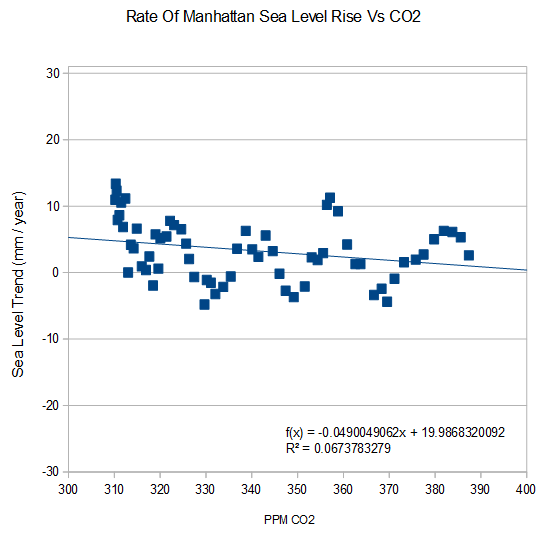As CO2 has risen, the rate of sea level rise at Manhattan has not. This is because the apparent sea level rise is due to subsidence.
Scientists who make claims linking the rate of sea level rise to atmospheric CO2 – are either incompetent, dishonest, or both. There is zero evidence to support that idea.



McKibben is smart, because he knows that this sort of information is not what most people care about. What most people care about is what kind of party he’s going to throw for them if they go to the trouble of traveling to New York City.
RTF
“Manhattan Sea Level Rise Shows No Correlation With CO2”
and
Climate Change Shows No Correlation With Changes in CO2 Levels.
In a recent meeting at work, we were presented with a report done for the provincial government. The report contained a graph of ‘anticipated’ sea level rise vs atmospheric CO2 concentrations. There are hundreds of millions if not billions of dollars (ok they are only Canadian dollars) worth of flood proofing works, dykes, land filling etc being implemented on this report. The report estimates sea level rise at 3X the current rates, a whopping 1m/century.
In the formal meeting nobody objected, but in one on one discussions afterward there were a few people who found the estimates ludicrous.
Only a few?
How about sneaking copies of these papers into the break room and critical desks.
Another paper:
http://www.soest.hawaii.edu/ericg/kap_paper.pdf
Sea-level highstand recorded in Holocene shoreline deposits on Oahu, Hawaii
http://jsedres.geoscienceworld.org/content/66/3/632.abstract
Abstract
Unconsolidated carbonate sands and cobbles on Kapapa Island, windward Oahu, are 1.4-2.8 (+ or – 0.25) m above present mean sea level (msl). Agreeing with Stearns (1935), we interpret the deposit to be a fossil beach or shoreline representing a highstand of relative sea level during middle to late Holocene time. Calibrated radiocarbon dates of coral and mollusc samples, and a consideration of the effect of wave energy setup, indicate that paleo-msl was at least 1.6 (+ or – 0.45) m above present msl prior to 3889-3665 cal. yr B.P, possibly as early as 5532-5294 cal. yr B.P., and lasted until at least 2239-1940 cal. yr B.P. Hence, the main phase of deposition on Kapapa Island lasted a minimum of c. 1400 yr and possibly as long as c. 3400 yr. No modern samples have been recovered from the fossil beach…Radiocarbon ages of coral and mollusc clasts from a breccia lining an emerged (1.4 + or – 0.25 m msl) intertidal notch, cut into emerged coralline-algal carbonate of presumed last interglacial age, on south Mokulua Island (15 km to the southeast of Kapapa Island) correlate to the history recorded on Kapapa Island. Calibrated ages range from 2755-2671 to 3757-3580 cal. yr B.P. (averaging c. 3100 cal. yr B.P.) suggesting that a higher than present sea level formed the notch prior to 3757-3580 cal. yr B.P….
The Authors interpret this data to agree with “subsidence based on models: ” This history is consistent with geophysical models of postglacial geoid subsidence over the equatorial ocean first predicted by Walcott (1972) and later refined by Clark et al. (1978) and Mitrovica and Peltier (1991).” However if the Southeast Vietnam coast was geologically stable and showing the same type of data, that interpretation based on models is open to question.
Paterson, New Jersey is a former sea floor as is Richmond, Virginia. The ocean reached nearly to the Appalachian mountains and much the entire modern “East Coast” was inundated. This is still visible in Google Earth maps.
If they insist on building more seawalls on the north shore of O`ahu it is very likely there will continue to be encroachment of the sea. Sad story of Lanikai (http://www.soest.hawaii.edu/coasts/erosion/?sArea=Lanikai http://www.hawaiinewsnow.com/story/15220715/work-begins-monday-to-slow-erosion-and-replenish-sand-at-kailua-beach )
The way Obama’s printing money your dollars are looking much better than our greenbacks right now.
You should invite me to your meetings. I always more than happy to be the one that “kicks the puppy” when people propose impossible scenarios and rave about their pet ideas… that usually violate the laws of physics. Needless to say the Sales guys don’t want me around until after they’ve sold the job… then I have to make the insane ideas work. (OK, maybe you don’t want me at your meetings, if you wish to keep your job.)
I wonder how much mischief is created by climate activists where both glacial isostatic adjustment and subsidence coincide. Add to that a chance bolide crater such as found in Chesapeake Bay and, well, the sky is the limit.
How about Gilligan’s Island, Season Two, Episode 6, “Quick, Before It Sinks”
http://www.imdb.com/title/tt1288877/
It seems that Gilligan’s Island Physics wins!
How sad that Gilligan and the Professor were right more often than main stream climate “science.”
I disagree completely, the .0023% increase in CO2 has resulted in a clear .0023% increase in temperature in last 18 years…
Reblogged this on Globalcooler's Weblog and commented:
The Nature Conservancy in Guilford is trying to show that not only the sea level will rise exponentially but so will the subsidence. What is the relationship between CO2 and subsidence?
“What is the relationship between CO2 and subsidence?
Unicorn farts?
🙂
That makes as much sense as anything else they spew.
Subsidence is dependent on which tectonic plate is getting sucked under. It has ZERO to do with CO2.
Deep Ocean Trenches and The Ring of Fire
Breakthrough achieved in explaining why tectonic plates move the way they do